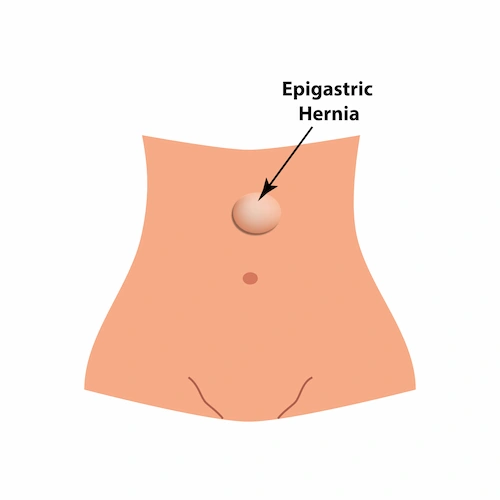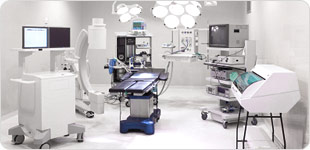Epigastric Hernia

A lump or protrusion can occur between the naval and chest.
At Hernia Center Los Angeles, we believe that educating our patients about hernias is an essential aspect of quality care. Our hernia surgeons are experienced in treating all types of abdominal wall hernias, including epigastric hernias in adults and in children.
- What is an Epigastric Hernia?
- Epigastric Hernia Causes
- Symptoms of an Epigastric Hernia
- Epigastric Hernias in Children
- Preparing for Epigastric Hernia Surgery
- Epigastric Hernia Treatment
- Recovery After Epigastric Hernia Surgery
- Frequently Asked Questions About Epigastric Hernias
What is an Epigastric Hernia?
An epigastric hernia is a type of abdominal hernia (ventral hernia) that occurs in the midline of the upper abdomen. It is usually located above the belly button (umbilicus) and below the breastbone. The hernia occurs when the fatty tissue or a portion of the intestine protrudes through a weakness in the abdominal wall. This weakness is usually caused by a defect in the abdominal muscles, which can be congenital or acquired.1
Epigastric hernias are relatively common. They are more common in men than in women and are usually seen in people over the age of 50. However, they can also occur in children and young adults.

Epigastric Hernia Causes
Epigastric hernias are often present at birth: a congenital weakness in the abdominal wall can go completely undetected for years, and then appear as a hernia.
Other risk factors that may cause an epigastric hernia include:
- Pregnancy
- Obesity
- Heavy lifting
- Chronic coughing
- Smoking
- Fluid in the abdominal cavity
- A previous abdominal surgery2
Symptoms of an Epigastric Hernia
Many people with an epigastric hernia do not experience any symptoms. The hernia may be discovered during a routine physical examination or an imaging test for another condition. However, in some cases, an epigastric hernia can cause symptoms, including:
- Pain or discomfort in the upper abdomen, especially when lifting heavy objects or straining
- A visible bulge or swelling in the upper abdomen
- Nausea or vomiting, especially if the hernia becomes strangulated or incarcerated
- Constipation or difficulty passing bowel movements
- Bloating
If the hernia becomes strangulated or incarcerated, it can lead to serious complications such as tissue death or bowel obstruction. These complex hernias require immediate medical attention.
Epigastric Hernias in Children
An epigastric hernia is a defect in the abdominal wall, and it needs to be repaired so that your child will grow up safely and naturally, without danger to his or her bowel system. You should schedule a consultation if you or your pediatrician notice a lump in your child's abdomen.
In a child, the epigastric hernia repair procedure is usually very simple. The hole is closed with sutures, and the abdominal muscles grow back together as the child grows.
Preparing for Epigastric Hernia Surgery
Before your epigastric hernia surgery is scheduled, you will attend a private consultation with one of our hernia surgeons. The doctor will conduct a physical examination and review of your medical history, then educate you about what to expect before, during, and after hernia surgery.
Epigastric Hernia Treatment
Surgery is the primary treatment for epigastric hernias. The goal of surgery is to repair the weakened area of the abdominal wall and prevent the hernia from recurring. At Hernia Center Los Angeles, our surgeons specialize in performing small-incision open surgery for epigastric hernia repair. This allows for superior accuracy and also reduces the rate of hernia recurrence.
The best epigastric hernia repair for you will depend on the exact nature of your hernia. Epigastric hernias may be simple, such as just a small hole in a weak spot in the abdominal fascia. In this case, our hernia surgeons recommend repairing the hernia by returning the bowel to its proper location, and then closing the hole in the abdominal wall.
Rectus diastasis, a separation of the abdominal muscles, can develop in individuals with an epigastric hernia. While both genders can experience this condition, it is more commonly observed in women, particularly following pregnancy. The rectus muscles run parallel to each other on either side of the abdomen and typically come together at the midline near the belly button. When the muscles become stretched or separated, diastasis occurs. Some common signs of rectus diastasis include noticeable abdominal bulging after eating, difficulty engaging the abdominal muscles, and weakened core strength.
If your epigastric hernia includes rectus diastasis, your abdominal muscles need to be repaired. Not only will this decrease the risk of hernia recurrence, but it will also strengthen your entire core.
Recovery After Epigastric Hernia Surgery
The recovery process following epigastric hernia surgery varies depending on the type of surgery performed and the individual patient. It is normal to experience some pain and discomfort for several days after surgery: your hernia doctor will prescribe pain medication to enhance your comfort.
After epigastric hernia repair, you will be advised to rest and refrain from some of your normal activities for at least one week to allow the surgical site to heal properly. Your hernia doctor may also instruct you to avoid lifting heavy objects or engaging in strenuous physical activity for several weeks.
You will need to follow up with your surgeon after surgery to monitor their progress and ensure that the hernia has not recurred.
Frequently Asked Questions About Epigastric Hernias
How is an epigastric hernia diagnosed?
An epigastric hernia is usually diagnosed through a physical examination by a healthcare provider. In some cases, imaging tests such as an ultrasound, CT scan, or MRI may be used to confirm the diagnosis and determine the size and location of the hernia.
Is surgery the only treatment option for epigastric hernias?
Surgical repair is the primary treatment for epigastric hernias. However, in cases where patients have small, asymptomatic hernias, doctors may recommend watchful waiting.
What are the risks of epigastric hernia surgery?
Any surgical procedure has some risks, but epigastric hernia surgery is generally considered to be a safe procedure. Rare risks and complications of epigastric hernia repair include:
- Bleeding
- Infection
- Issues with anesthesia
- Damage to nearby tissues or organs3
Contact Us
If you or your child has been diagnosed with an epigastric hernia, contact Hernia Center Los Angeles to learn more about your treatment options during a private consultation with an experienced hernia doctor.
1 Cleveland Clinic. Hernia. Available: https://my.clevelandclinic.org/health/diseases/15757-hernia. Accessed March 31, 2023.2 Brigham and Women's Hospital. What is an umbilical or epigastric hernia? Available: https://docs.google.com/document/d/1q9zSjqLkhElG2jmOJLoPX-gvB1TU_aXZtXZ1ZcKiTo0/edit#. Accessed March 31, 2023.
3 University of Pittsburgh School of Medicine. Hernia Surgery Benefits, Risks, and What to Expect. Available: https://www.upmc.com/services/general-surgery-trauma/services/hernia-surgery. Accessed March 31, 2023.



